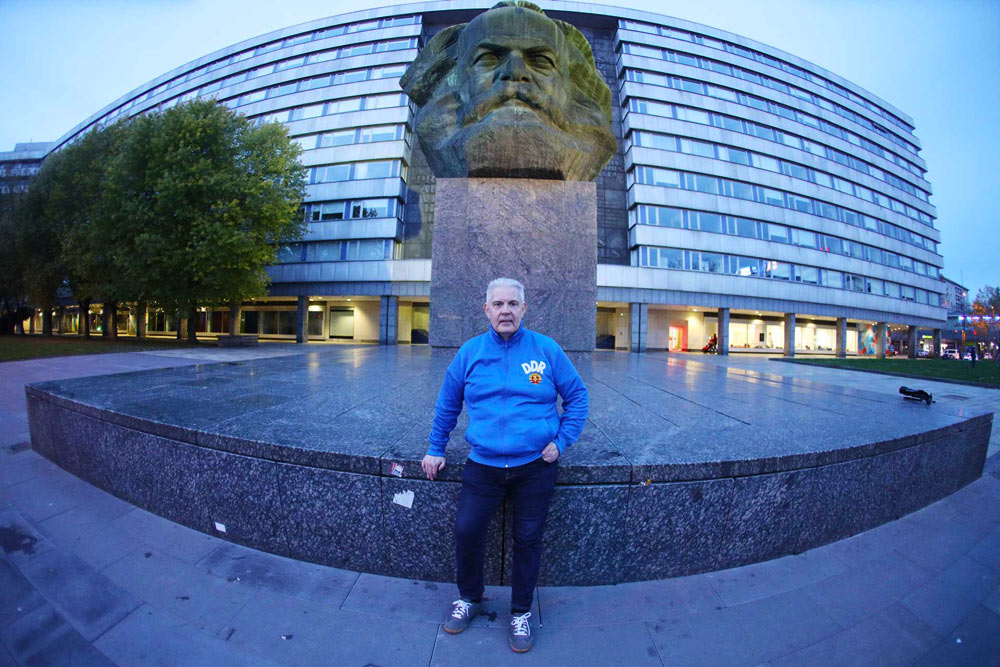Few tourists bother with the old East German cities beyond Berlin. But not Globe Trotsky. While many of the old Communist-era symbols were removed following reunification, a few iconic monuments still remain for those willing to seek them out. Chemnitz in Southwest Germany is one of the destinations worth ‘heading’ to.
Big-headed on Brutalism

A cold, short, winter day in the small German City of Chemnitz, is not everyone’s idea of a tourist day out.
But with a fascination for socialist realist sculpture and brutalist architecture, I had been salivating ahead of this trip for a several years.
Around an hour’s bus ride from my Dresden base, the town of Chemnitz has a fairly unremarkable reputation.
Little Manchester
Situated at the foot of the Erzgebirge (literally translated as “ore mountains”) it became an important area of industrial production.
Such was its growth, which included coal mining and as machinery centre, it was christened Little Manchester in the 1700s.
Allied Destruction
Fast forward to the 20th century and the Second World War and this made Chemnitz a prime target for the Allied bombers.
So much so that the city was obliterated during the conflict to disrupt the Nazi war effort. By 1945 it was completely destroyed.
Reinventing the City

It was rebuilt under the new communist government of the German Democratic Republic (DDR). And In 1953 it was renamed Karl-Marx Stadt.
Incongruous, as Marx – who hailed from Trier on the opposite side of Germany near the French border – had never visited the city and had no obvious connection with the place!
Bronze Bust Brutalism
After renaming, the East German government commissioned the famous Soviet sculptor, Lev Kerbel, to design a new monument featuring the fathering of communism, Karl Marx, for its newly-named city.

The bronze monument of Karl Marx was cast by Kerbel in Leningrad and then broken down in to 95 pieces. (Soviet technology and welding techniques were deemed not up to the job and the brought to Germany to be reassembled.)

Socalist Realism
Finally, on the 9 October 1971, the monument was unveiled by Communist Party General Secretary Erich Honecker in front of a crowd of 250,000 East Germans and party members.

I had seen images of the statue before, but nothing prepared me for the sheer scale of this masterpiece of Socialist Realism. The head itself is just under 25 feet in height. Together with the plinth, the brutalist bust stands at 42 feet high and weighs 40 tonnes. For anyone with socialist bone in their body it truly is magic moment to walk beneath this giant of political and economic history.
Monumental Manifesto
Set in the wall behind is the political rally cry: “Workers of the World Unite, you have nothing to lose but your chains”. The inscription, quoted from the Communist Manifesto of 1848, is written in four languages: German, English, French and Russian.

As the landmark of the city, it served during holidays in the German Democratic Republic as a backdrop for party pageants and other mass events.

Skull Alley
Until 2007, the motto of the city was “Stadt mit Köpfchen” (the city with heads/brains), referring to the monument. And locals still refer to the road as Nischelgasse or “Skull Alley”, not Brückenstrasse, its proper street name.

The Karl Marx Monument in Chemnitz is believed to be the second largest bust in the world behind on of Lenin’s head in Ulan-Ude, Russia, which is six centimetres taller.

Using Brains
Like most Communist-era symbols there was intense debate about its future following “de Wende” (the Turn) as Germans call reunification. And despite the city reverting to its original name of Chemnitz from Karl Marx Stadt in 1991, locals have decided to retain this amazing monument as an important part of the city’s identity.
It takes brain to do that. Globe Trotsky for one is pleased he got the chance to see it.



Head shot of Karl Marx and wall frieze words, Workers of the World Unite, Visit to Karl Marx statue, Skull Alley, Brukenstrasse, Chemitz 
My DDR tracksuit top was purchased from Copa who sell a wide range of retro football strips.



1 Comment
Prague: City of Contrasts - Globe Trotsky · at
[…] then, video blogging was a whole new game and much of the Dresden trip was spent trying to familiarise myself with a new camera and audio and the whole […]